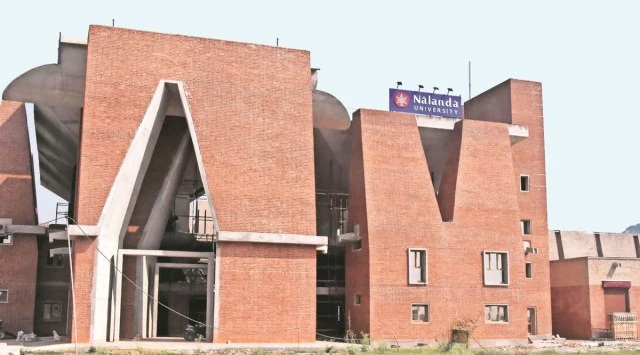Introduction
Nalanda University, an iconic beacon of ancient wisdom and scholarship, stands as a testament to the golden era of intellectual and cultural flourishing in India. Established in the 5th century CE by Kumaragupta I during the Gupta Empire—a period often heralded as the Golden Age of India—Nalanda was more than just a center of learning; it was a vibrant hub of intellectual exchange and cross-cultural dialogue.
The political stability and economic prosperity of the Gupta Empire created an ideal environment for Nalanda to thrive, evolving into a sprawling campus with numerous temples, monasteries, and lecture halls. Scholars from diverse regions, including China, Korea, Japan, Tibet, Mongolia, Turkey, Sri Lanka, and Southeast Asia, were drawn to Nalanda, enriching it with a melting pot of ideas and traditions.
Nalanda university curriculum was vast, covering an array of subjects from Buddhism, Hinduism, and Jainism to secular disciplines such as medicine, mathematics, astronomy, and logic. Students immersed themselves in studying key texts, engaging in logical debates, and practicing Ayurveda—a holistic system of medicine.
The History and Significance
Nalanda University, founded in the 5th century CE by the Gupta emperor Kumaragupta, represents one of the most illustrious centers of learning in ancient history. Nestled in the verdant plains of Bihar, India, Nalanda University thrived during a period marked by cultural and intellectual flourishing, becoming a beacon of knowledge and scholarship that attracted students and scholars from across Asia.
Nalanda University’s magnificent library houses a staggering collection of texts on diverse subjects, with Buddhist philosophy at its core, but also covering disciplines such as logic, medicine, astronomy, and literature. Manuscripts were meticulously preserved, copied, and translated, ensuring the continuity of knowledge.
The university’s faculty comprised some of the era’s most brilliant minds, such as Dharmapala, Shilabhadra, and Nagarjuna, who attracted students eager to learn from their wisdom. These scholars engaged in discourse and debate, fostering an environment of critical thinking and intellectual exploration. Nalanda transcended geographical and cultural boundaries, becoming a global hub of exchange where students from China, Korea, Japan, Tibet, Southeast Asia, and Central Asia converged.
This influx of diverse minds fostered a vibrant exchange of ideas and traditions, epitomized by the Chinese scholar Xuan Zang, who studied at Nalanda in the 7th century CE and left detailed accounts of its life, highlighting its multicultural character and dedication to knowledge. Nalanda University’s significance lay not just in its vast knowledge base but also in its commitment to interdisciplinary learning, where philosophy and medicine intertwined, logic illuminated religious texts, and astronomy guided travelers.
By the 12th century CE, the university faced a series of invasions and destructions, with political turmoil and economic disruptions contributing to its decline. Despite the loss of patronage and the dispersal of scholars, the legacy of Nalanda University refused to be silenced. The ruins stood as a testament to its grandeur, inviting future generations to rediscover its spirit.

The Revival Efforts and the Modern Nalanda University
The idea of reviving Nalanda University began to take shape in the early 21st century, driven by a collective desire to restore a historical symbol of knowledge and cultural exchange. This ambitious endeavor faced numerous challenges, from securing adequate funding to obtaining international cooperation and navigating complex bureaucratic hurdles. Key figures and institutions from various Asian countries, recognizing the significance of Nalanda’s heritage, played crucial roles in these negotiations.
Their efforts culminated in the passage of the Nalanda University Act by the Indian Parliament in 2010, officially marking the beginning of the modern university’s revival. The project garnered support from several countries, including China, Japan, Singapore, and Thailand, reflecting the deep historical ties and shared cultural heritage that connected these nations to Nalanda.
The architectural design of the modern Nalanda University campus is a remarkable blend of ancient inspiration and contemporary innovation. The master plan, developed by renowned architect Balkrishna Doshi, draws from the layout and aesthetics of the ancient ruins while incorporating modern sustainability principles. The campus features state-of-the-art academic buildings, residential facilities, and green spaces designed to promote a conducive environment for learning and research. Elements such as brickwork, courtyards, and water bodies echo the ancient structures, creating a sense of continuity with the past. The design also emphasizes energy efficiency, water conservation, and the use of local materials, aligning with contemporary environmental concerns and sustainability goals.
The curriculum at the modern Nalanda University aims to balance the revival of traditional subjects with the inclusion of contemporary fields of study. This approach reflects the interdisciplinary nature of the original Nalanda while addressing the needs and challenges of the 21st century. The programs offered include Buddhist Studies, Philosophy, and Comparative Religion, which echo the university’s historical strengths.
The Modern Relevance and Importance of Nalanda’s Revival
One of the key missions of the modern Nalanda University is to serve as a platform for promoting intercultural dialogue and understanding. By bringing together students and faculty from various countries and cultural backgrounds, Nalanda fosters an environment where diverse perspectives can interact and enrich each other. Exchange programs, joint research initiatives, and cultural festivals are among the ways Nalanda facilitates this dialogue. Partnerships with universities in Japan, China, and Thailand enable collaborative research on topics of mutual interest, such as Buddhist studies and environmental sustainability. These interactions help build bridges between different cultures and promote a deeper understanding of shared histories and challenges.
Nalanda’s interdisciplinary approach to education uniquely positions it to address global challenges like climate change, poverty, and pandemics. The university’s focus on Environmental Studies includes research on sustainable agriculture, water management, and renewable energy, leveraging the diverse expertise of its faculty and students. The emphasis on critical thinking and ethical considerations ensures that graduates are well-equipped to tackle these complex issues with a holistic perspective.
The revival of Nalanda University is more than just the restoration of a historical institution; it is a reaffirmation of the enduring importance of intellectual exchange, critical thinking, and the pursuit of knowledge. By bridging the past and the present, Nalanda inspires future generations to appreciate the richness of human heritage and to contribute to the creation of a more informed, interconnected, and compassionate world. Its revival serves as a powerful reminder of what can be achieved when nations and cultures come together with a shared vision of learning and cooperation.
Inauguration Ceremony
Prime Minister Shri Narendra Modi inaugurated the new campus of the Nalanda University near Rajgir, Bihar. On this occasion, he also planted a sapling of the Bodhi tree- an enduring symbol of Buddhist heritage and Indian spirituality, at the campus. Governor of Bihar, Shri Rajendra Vishwanath Arlekar, Chief Minister of Bihar, Shri Nitish Kumar, External Affairs Minister Dr. S. Jaishankar, MoS for External Affairs, Shri Pabitra Margherita and Chancellor of the University, Prof. Aravind Panagariya were among the dignitaries present on this occasion.
Along with India, there are 17 Participating Countries in this endeavor – Australia, Bangladesh, Bhutan, Brunei Darussalam, Cambodia, China, Indonesia, Laos, Mauritius, Myanmar, New Zealand, Portugal, Singapore, South Korea, Sri Lanka, Thailand, and Vietnam. Ambassadors of these countries traveled to Nalanda University to participate in the inaugural ceremony.

Vision and mission of the new Nalanda University
To revive Nalanda University as a premier institution of higher learning, fostering global understanding and scholarly excellence rooted in Indian intellectual traditions. Establishment of an international institution for the pursuit of intellectual, philosophical, historical, and spiritual studies and matters connected in addition to that or incidental to it.
The revival of the Nalanda University to improve regional understanding and the appreciation of one another’s heritage and history. To build a community of learning where students, scholars, researchers, and academicians can work together symbolizing the spirituality that unites all mankind.
the aspiration of the new Nalanda University to not only reclaim its historical significance but also to establish itself as a beacon of modern education rooted in ancient wisdom, fostering a global community of scholars and leaders committed to intellectual growth and societal advancement.
Plans for future growth and development
Expansion of Academic Programs: Introducing new undergraduate and postgraduate programs across various disciplines, including humanities, social sciences, natural sciences, and interdisciplinary studies. This expansion aims to attract a diverse student body and cater to emerging fields of study.
Faculty Development: Attracting top-tier faculty from around the world by offering competitive compensation packages, research support, and opportunities for professional growth. Emphasizing interdisciplinary collaboration and fostering a supportive academic environment.
Research Excellence: Establishing research centers of excellence focused on critical global challenges such as sustainable development, public health, climate change, and technological innovation. Encouraging interdisciplinary research that integrates traditional knowledge systems with modern scientific approaches.
Infrastructure Enhancement: Investing in state-of-the-art facilities, laboratories, libraries, and digital resources to support cutting-edge research and innovative teaching methods. Creating a conducive environment for learning and scholarly activities.
International Collaboration: Strengthening partnerships with leading universities, research institutions, and industry globally. Promoting exchange programs, joint research initiatives, and dual degree programs to enhance academic collaboration and global perspectives.
Student Support Services: Enhancing student services including scholarships, career counseling, mentorship programs, and extracurricular activities to ensure holistic development and well-being of students.
Sustainability Initiatives: Implementing environmentally sustainable practices across campus operations, promoting research on sustainability issues, and integrating sustainability principles into academic curriculum.
Conclusion
The revival of Nalanda University marks a significant milestone in the landscape of global higher education. Rooted in its illustrious past as a beacon of knowledge and intellectual exchange in ancient India, the new Nalanda University is poised to redefine academic excellence in the 21st century.
With a steadfast commitment to scholarly rigor, interdisciplinary collaboration, and the integration of traditional wisdom with modern knowledge systems, Nalanda University aspires to nurture the next generation of global leaders and thinkers. Its vision to foster a deep understanding of diverse cultures, promote sustainable development, and address pressing global challenges reflects its role as a catalyst for positive change in the world.
-BHAWNA AND SNEHA
MUST READ: NEET UG 2024: 67 PERFECT SCORES AND 1,563 STUDENTS GOT GRACE MARKS THAT FUEL THE CONTROVERSY

